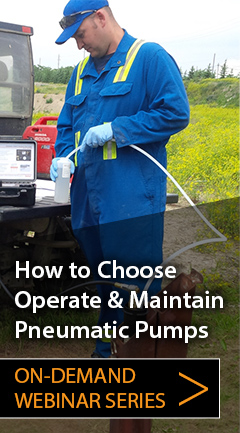Double Valve Pump Operating Principles
When the Solinst Double Valve Pump (DVP) is placed in a well or borehole, water rises inside the pump and the twin tubes to static level. A Control Unit is used to deliver compressed gas to the pump. During the drive period the gas pushes down on the water column contained in the drive line tubing, closing the check valve at the base of the pump. This forces water up the sample line tubing.
A vent period, during which the gas is released, allows hydrostatic pressure to refill the pump and drive line with sample water. The top check valve prevents water in the sample line from falling back into the pump body. This pressurization and vent cycle is repeated manually or automatically as set by the timers on the Control Unit. The cycle may be regulated for purging or sampling.
Note:
- The maximum lift for stainless steel pumps is 150 m (500 ft).
- DO NOT exceed an operating pressure of 250 psi.
- An external filter (#112832) is recommended if using a compressor to operate the Double Valve Pump.
- Tube fittings are based on use of 1/4" drive line and 1/4" sample line. Optional 3/8" tubing barbs (#114845) are available if 3/8" drive line tubing is preferred. See page 3 for instructions to change the fitting.
Note:
The pump has been decontaminated before leaving Solinst however, you may wish to decontaminate your pump before use. The pump should be decontaminated between wells.



